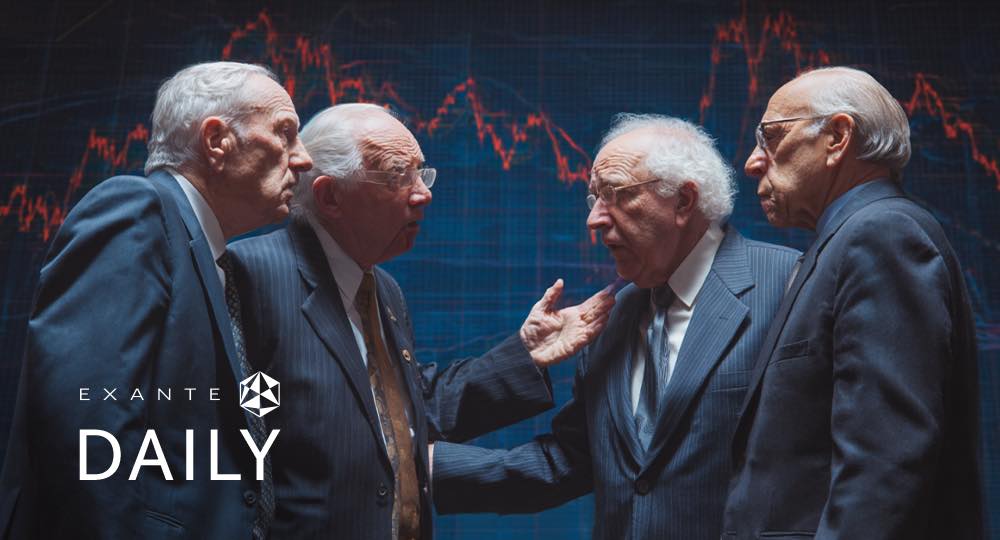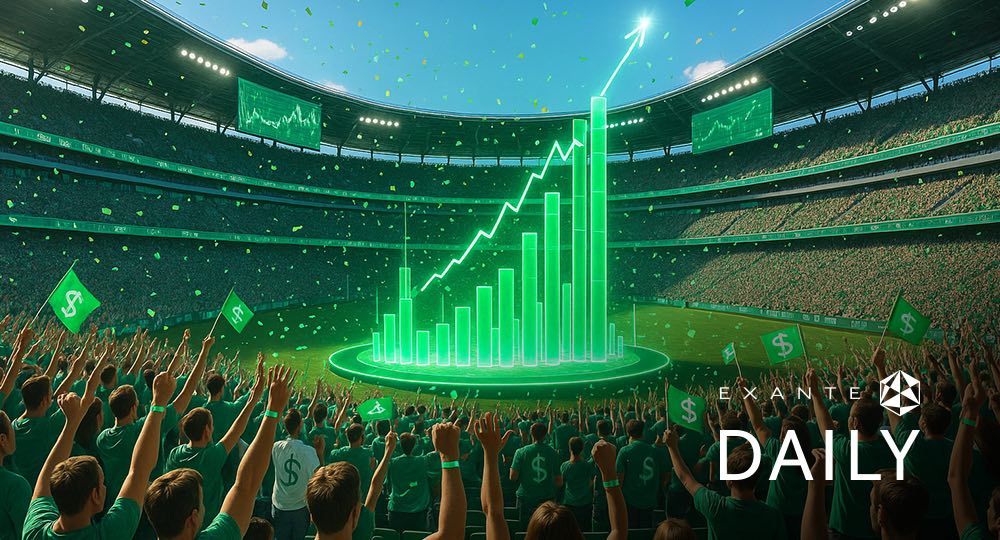What to look out for today
Companies reporting on Wednesday, 6th August: Airbnb, DoorDash, McDonald’s, NRG Energy, Mosaic, Walt Disney, TKO Group Holdings, Uber Technologies
Key data to move markets today
EU: German Factory Orders and Eurozone Retail Sales.
US: Speeches by Boston Fed President Susan Collins, Fed Governor Lisa Cook, and San Francisco Fed President Mary Daly.
US Stock Indices
Dow Jones Industrial Average -0.14%.
Nasdaq 100 -0.73%.
S&P 500 -0.49%, with 7 of the 11 sectors of the S&P 500 down.
All three major US stock indexes ended in the red on Tuesday. The S&P 500 dropped -0.49%, the Dow Jones Industrial Average slipped -0.14%, and the Nasdaq Composite lost -0.65%.
The day started strong, with stocks opening higher, but they slumped following weaker-than-expected data from the Institute for Supply Management (ISM). In addition, President Trump said he will unveil tariffs on semiconductors and pharmaceuticals ‘within the next week or so’ and that import taxes on drugs could ultimately reach 250%. Such a move could have significant consequences for the pharmaceutical and wider healthcare sector and raise US CPI as medical care is part of the CPI calculation.
In corporate news, Amazon announced it will offer OpenAI's new artificial intelligence models to its customers. This is the first time the cloud computing giant has provided products from the leading AI startup.
Amgen also raised its 2025 financial guidance after its quarterly results beat expectations, thanks to strong sales of older medications like the cholesterol-lowering drug Repatha.
Taiwan prosecutors arrested six people suspected of stealing trade secrets from Taiwan Semiconductor Manufacturing. This has opened an investigation into a potential national security breach involving a global tech leader.
S&P 500 Best performing sector
Materials +0.80%, with Dow +3.66 %, Newmont +2.78 %, and Celanese +2.66%.
S&P 500 Worst performing sector
Utilities -1.05%, with AES -5.21%, American Water Works Company -3.74%, and Constellation Energy -3.19%.
Mega Caps
Alphabet -0.22%, Amazon +0.99%, Apple -0.21%, Meta Platforms -1.66%, Microsoft -1.47%, Nvidia -0.97%, and Tesla -0.17%.
Information Technology
Best performer: Palantir +7.85 %.
Worst performer: Gartner -27.55%.
Materials and Mining
Best performer: Dow +3.66 %
Worst performer: Ball -5.75%.
European Stock Indices
CAC 40 -0.14%.
DAX +0.37%.
FTSE 100 +0.16%.
As of 5th August, according to LSEG I/B/E/S data for the STOXX 600, Q2 2025 earnings are expected to increase 3.1% from Q2 2024. Excluding the Energy sector, earnings are expected to increase 6.4%. Q2 2025 revenue is expected to decrease 2.0% from Q2 2024. Excluding the Energy sector, revenues are expected to remain unchanged. Of the 198 companies in the STOXX 600 that have reported earnings by 5th August for Q2 2025, 53.0% reported results exceeding analyst estimates. In a typical quarter 54% beat analyst EPS estimates. Of the 258 companies in the STOXX 600 that have reported revenue for Q2 2025, 48.8% reported revenue exceeding analyst estimates. In a typical quarter 58% beat analyst revenue estimates.
Health Care is the sector with most companies reporting above estimates at 71%. Financials with a surprise factor of 12.1%, is the sector that beat earnings expectations by the highest surprise factor. In the Basic Materials sector, 74% of companies have reported below estimates, and its earnings surprise factor was the lowest at -10.8%. The STOXX 600 surprise factor is 5.5%, which is above the long-term (since 2012) average surprise factor of 5.8%. The forward four-quarter price-to-earnings ratio (P/E) for the STOXX 600 sits at 14.2x, matching the 10-year average of 14.2x.
During the week of 11th August, 23 companies are scheduled to report Q2 earnings.
Corporate Earnings Reports
Posted on Tuesday, 5th August
- Advanced Micro Devices quarterly revenue +31.7% to $7.685 bn vs. $7.685 bn estimate.
EPS at $0.48 vs. $0.48 estimate.
Lisa Su, Chair and CEO, said, “We delivered strong revenue growth in the second quarter led by record server and PC processor sales. We are seeing robust demand across our computing and AI product portfolio and are well positioned to deliver significant growth in the second half of the year, driven by the ramp of our AMD Instinct MI350 series accelerators and ongoing EPYC and Ryzen processor share gains.” — see report.
- Rivian Automotive quarterly revenue +12.5% to $1.303 bn vs. $1.303 bn estimate.
Loss Per Share at -$0.80 vs. -$0.89 estimate.
RJ Scaringe, Founder and CEO, said, “This quarter we made significant progress in R2 development and testing. We also substantially completed the expansion of our Normal, Illinois facility and have begun installing manufacturing equipment in preparation for our start of production. Along with R2, our autonomy platform continues to be one of our major focus areas, and we're excited to share more of our roadmap later this year.” — see report.
- Snap quarterly revenue +8.7% to $1.345 bn vs. $1.343 bn estimate.
Loss Per Share at -$0.16 vs. -$0.16 estimate.
Evan Spiegel, CEO, said, “Our global community continued to grow in Q2, reaching 932 million Monthly Active Users as we continued to invest in AI and augmented reality. With meaningful inventory and conversions growth this quarter, including the broader rollout of Sponsored Snaps, we’re excited about the opportunity to translate improved advertiser performance into topline acceleration.” — see report.
Commodities
Gold spot +0.23% to $3,382.08 an ounce.
Silver spot +1.18% to $37.84 an ounce.
West Texas Intermediate -1.66% to $65.22 a barrel.
Brent crude -1.51% to $67.67 a barrel.
On Tuesday, gold prices advanced to a near two-week high, buoyed by increasing expectations of interest rate cuts in the US. The market is also awaiting the US President's forthcoming decision regarding appointments to the Federal Reserve Board.
Spot gold rose by +0.23% to settle at $3,382.08 per ounce, after reaching its highest point since 24th July earlier in the session.
Although the US dollar ended the day +0.16% higher, it had edged lower earlier in the session, which made dollar-denominated gold more affordable for holders of other currencies and provided initial support.
Oil prices declined on Tuesday as traders considered the increase in OPEC+ supply and concerns over softening global demand. These elements overshadowed the geopolitical tensions stemming from the US President's threats to India regarding its imports of Russian oil.
Both major crude benchmarks settled at their lowest levels in five weeks. Brent crude futures decreased by $1.04, or -1.51%, closing at $67.67 a barrel, while WTI crude fell by $1.10, or -1.66%, to $65.22.
OPEC+ agreed on Sunday to increase oil production by 547,000 barrels per day (bpd) for September. This decision effectively ends its recent output cuts sooner than initially planned.
The US President reiterated threats of higher tariffs on Indian goods within 24 hours in response to the country's purchases of Russian oil. The President also suggested that lower energy prices could pressure Russian President Vladimir Putin to cease the conflict in Ukraine. In a defiant response, India labelled threats as ‘unjustified’ and committed to safeguarding its economic interests, further exacerbating the trade rift between the two nations.
India remains the largest buyer of seaborne crude from Russia, importing approximately 1.75 million bpd between January and June of this year, which represents a 1% increase from the same period last year.
Note: As of 5 pm EDT 5 August 2025
Currencies
EUR +0.04% to $1.1573.
GBP +0.10% to $1.3293.
Bitcoin -1.34% to $113,597.37.
Ethereum -3.65% to $3,575.37.
The US dollar strengthened on Tuesday, though it remained near the lows it hit last Friday as the market continued to react to the weak US jobs report.
Market attention is now focused on the upcoming personnel changes at the Fed, which are likely to result in a more dovish central bank that is in line with the White House's objectives. On Tuesday, the US President announced that he would soon be making decisions regarding both a short-term replacement for Fed Governor Adriana Kugler, who resigned last Friday, and his choice for the next Fed chair.
Despite the focus on the Fed, uncertainty over tariffs remains a key concern. The latest duties imposed by the US President on imports last week have heightened worries about the stability of the global economy.
In afternoon trading, the dollar index rose +0.16% to 98.76, recovering from a one-week low of 98.61 earlier in the day. However, the euro gained +0.04% against the dollar, reaching $1.1573.
The dollar rose +0.31% against the Japanese yen to ¥147.56 after minutes from a June policy meeting showed that some BoJ Board members would consider resuming rate increases if trade tensions ease.
Sterling edged higher against both the dollar and the euro. The pound was up +0.10% against the dollar at $1.3293 and +0.30% against the euro at 86.85 pence.
The BoE is widely expected to cut its key interest rate to 4.00% from 4.25% tomorrow and to lower it once more before the end of the year. Traders have priced in over a 90% chance of an easing move this week and a total of 86 bps of rate cuts by December 2026. However, the vote is likely to be split, with some policymakers focussing on a weakening labour market while others point to the continuing overshoot in inflation and rising inflation expectations.
Fixed Income
US 10-year Treasury +2.1 basis points to 4.218%.
German 10-year bund +0.6 basis points to 2.634%.
UK 10-year gilt +1.2 basis points to 4.522%.
US Treasury yields were mostly higher on Tuesday after three straight days of declines, but they eased following data that indicated a stall in the services sector.
The ISM non-manufacturing PMI fell to 50.1 last month. This was below both the 51.5 estimate and the 50.8 recorded in June.
The yield on the 10-year note was +2.1 bps to 4.218% on Tuesday, after reaching an intraday high of 4.226%. Over the previous three sessions, the 10-year yield had fallen by 18 bps, marking its largest three-day decline since mid-April.
The yield on the 30-year bond fell -1.0 bps to 4.786%, after having climbed to 4.815% earlier in the day. The two-year Treasury yield, which is sensitive to interest rate expectations, rose +5.4 bps to 3.739%. It had previously dropped by nearly 26 bps over the past three sessions, its biggest decline in a year.
Yields saw a slight increase following a $58 billion auction of 3-year notes. Analysts viewed the auction as somewhat soft, with demand at 2.53 times the notes on sale, below average. More supply will enter the market this week with a $42 billion auction of 10-year notes scheduled for today and a $25 billion auction of 30-year bonds due tomorrow.
Following Governor Adriana Kugler’s resignation from the Fed on 8th August, and with Fed Chair Jerome Powell's term ending in May 2026, President Trump announced he would be making his nominations to replace them. Market participants expect any nominees to hold more dovish views as the current administration has advocated for rate cuts and a weaker dollar.
Fed funds futures traders are now pricing in a 87.4% probability of a rate cut in September, up from 63.3% last week, according to CME Group's FedWatch Tool. Traders are currently anticipating 58.6 bps of cuts by year-end, higher than the 45.3 bps expected last week.
Across the Atlantic, eurozone bond yields moved slightly higher on Tuesday, with the spread between Italian, German, and French yields reaching its narrowest point in years.
The 10-year German bond yield rose +0.6 bps to 2.634%, recovering from a two-week low earlier in the day. German yields edged up after new data revealed that business activity in the eurozone grew at a slightly faster pace in July than in June, offsetting some of the market's earlier caution.
The 10-year Italian bond yield fell by -1.1 bps to 3.428%. Following a 7.9 bps drop on Monday, the spread between Italian and German 10-year yields have narrowed to 79.4 bps—its tightest level since 2010.
Italy's spread to France has also tightened to 13.7 bps, the narrowest since 2007, due to ongoing political uncertainty and fiscal concerns in France.
Note: As of 5 pm EDT 5 August 2025
Global Macro Updates
July ISM Services Index below consensus, new orders and employment receding, price pressures intensified. The Institute for Supply Management (ISM) Services Index for July came in at 50.1, a decrease from June's 50.8 and falling short of the consensus forecast of 51.4.
The New Orders Index dropped from 51.3 to 50.3, though it remains in expansion territory. The Employment Index contracted for the second consecutive month, declining from 47.2 to 46.4. The Prices Index increased from 67.5 to 69.9, reaching its highest level since October 2022.
The report noted that July's reading reflects slow growth, with survey respondents citing seasonal and weather factors as having a negative impact on business. Tariffs were also a widely cited concern, as participants reported higher costs, delays, and a lack of clarity that led to project postponements. There was also mention of companies' extra purchasing to get ahead of tariffs, which now seems to be levelling off.
In contrast, the final S&P Global Services PMI for July rose to a seven-month high of 55.7, up from 52.9 in June. This report indicated that new orders expanded at their fastest pace since January 2025. It also noted that input prices rose sharply, with the pace of inflation accelerating and being linked to the impact of tariffs.
President Trump’s interview on CNBC. The US President's appearance on CNBC generated significant headlines on a slow newsday, though his remarks did not immediately create market-moving events.
President Trump announced he would ‘substantially’ raise tariffs on India within the next 24 hours, citing the country's purchases of Russian oil. He also noted that tariffs on the pharmaceutical and semiconductor sectors would be announced soon.
Regarding pharmaceuticals, he stated that an initial ‘small tariff’ would be imposed, with the rate potentially rising to 150% within 12 - 18 months and eventually reaching up to 250%.
On the semiconductor front, he emphasised his goal of having chips manufactured in the US. President Trump also threatened the EU with a 35% tariff rate if it fails to meet its obligations. Additionally, he mentioned that the US and China are ‘very close’ to a trade deal and that he would meet with Chinese President Xi Jinping before the end of the year if an agreement is reached.
In a discussion on the Fed, President Trump indicated that a decision on the next Fed chair could come ‘fairly soon,’ stating he had narrowed the field to four candidates. He also confirmed that Treasury Secretary Bessent was no longer being considered for the position, as Bessent wishes to remain in his current role.
While every effort has been made to verify the accuracy of this information, EXT Ltd. (hereafter known as “EXANTE”) cannot accept any responsibility or liability for reliance by any person on this publication or any of the information, opinions, or conclusions contained in this publication. The findings and views expressed in this publication do not necessarily reflect the views of EXANTE. Any action taken upon the information contained in this publication is strictly at your own risk. EXANTE will not be liable for any loss or damage in connection with this publication.
Este artigo é-lhe fornecido apenas para fins informativos e não deve ser considerado como uma oferta ou solicitação de uma proposta para compra ou venda de quaisquer investimentos ou serviços relacionados que possam ser aqui referenciados. A negociação de instrumentos financeiros envolve um risco significativo de perda e pode não ser adequada para todos os investidores. O desempenho passado não é um indicador fiável do desempenho futuro.






